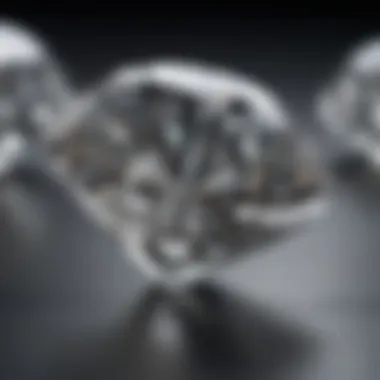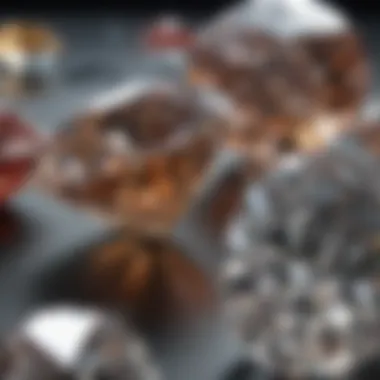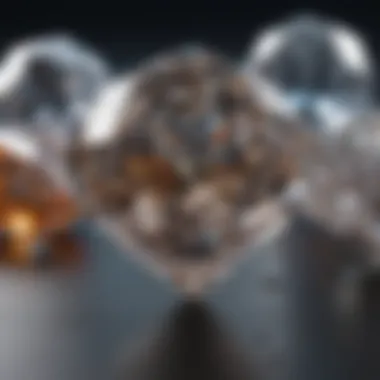Understanding Composite Diamonds: Definition and Implications


Intro
Composite diamonds represent a significant evolution in gemology and materials science. Defined as diamonds comprising two or more distinct components, they exhibit unique properties and usage potentials that differ sharply from traditional diamond forms. As industries search for innovative materials, understanding these composite jewels is increasingly important. The exploration covers their creation, ethical considerations, and implications for commerce and technology.
Understanding Composite Diamonds
Composite diamonds are distinct from both natural and lab-grown diamonds. They may incorporate various elements or combine with synthetic materials. The unique structure of composite diamonds can influence their optical, physical, and chemical properties. With ongoing advancements in technology, these gems are a viable alternative where traditional diamonds may not be appropriate. They cater to demands across multiple sectors, including electronics and medical devices.
The following sections explain the creation processes, applications, and ethical implications surrounding these diamonds today. Insights will offer a round view regarding how composite diamonds have begun to reshape perspectives and practices in both gem and materials industries.
The Process of Creation
Creating composite diamonds generally involves controlled conditions similar to those in natural diamond formation. Some methods include High Pressure High Temperature (HPHT) or Chemical Vapor Deposition (CVD). These processes can lead to the formation of composite structures with desirable characteristics.
In contrast to natural mortals, synthetic options allow for precision and versatility. Depending upon the desired outcome, variations in pressure, temperature, and chemical precursors can yield different results, thus making composite diamonds a highly customizable option in manufacturing.
Aside from technical creation methods, understanding the materials included in the process allows for informed decisions concerning the applications of composite diamonds.
Applications of Composite Diamonds
The implications of composite diamonds reach far and diversify across several sectors:
- Technology: Their unique properties enable advances in electronics and semiconductor devices, offering solutions in thermal conductivity and hardness.
- Medical Devices: In medical fields, composite diamonds find application in various tools, enabling precision and reliability.
- Jewelry: Next-level aesthetics in fashion often call for materials that stand apart. Composite diamonds can present eye-catching alternatives to traditional pieces.
Composite diamonds represent innovation through careful synthesis. This paves the way for future technology while promoting further exploration into naturally-sourced alternatives.
Ethical Considerations
The ethics of synthetic options in time raise impactful questions particularly within the field of from where diamonds originate. Composite diamonds present relatively fewer environmental and social concerns associated with mining. However, due diligence is essential for ensuring practices such as proper sourcing and economical labor conditions. The shift towards using composite diamonds must hinge upon knowledge and awareness within consuming communities, pushing more retailers to disclose comprehensive origins behind their gems and materials.
Marking leaps in physical sciences intertwined with ethical ramifications offers a complete view of composite diamonds – as traditional choices are reevaluated in light of better understanding of environmental impacts.
Definition of Composite Diamonds
The term composite diamonds refers to a specific category of diamonds characterized by their unique qualities that emerge from a mix of both synthetic and natural methodologies. Understanding composite diamonds is essential as their presence in the gem and materials science industries marks a significant shift in how we perceive high-value materials.
Composite diamonds are increasingly sourcing attention for several reasons. They balance affordability with quality, making them an appealing option for both collectors and consumers. While natural diamonds often command a high market price, composite diamonds allow access to diamond-like materials without the associated ethical concerns of traditional diamond mining. This section will illuminate the attributes that define composite diamonds, setting the groundwork for a more comprehensive exploration of their production processes and various applications.
Basic Characteristics
Composite diamonds possess certain traits that distinguish them from traditional diamonds. First and foremost, they are engineered for both aesthetic and functional purposes. In terms of visual attributes, composite diamonds exhibit clarity, brilliance, and hardness that closely mimic those of natural diamonds. However, their pricing remains significantly lower due to the synthesis involved.
Another important aspect is the versatility of composite diamonds. They are used not only in jewelry but also in various industrial applications such as cutting tools, optical devices, and medical instruments. The growing integration of composite diamonds into diverse sectors reflects their adaptability and the increasing demand for alternatives to natural diamonds.
Composition and Structure
The composite diamonds are composed chiefly of carbon, similar to their natural counterparts, but the process of their formation and resultant structure varies significantly. Generally, composite diamonds can contain both high-quality synthetic materials and recycled diamond materials. This duality enhances their performance both in terms of industrial usage and aesthetic appeal.
Microscopic examination reveals that the internal structure of composite diamonds differs due to the presence of synthetic components. Often, these inclusions can be detected using polarizing light microscopes, marking a contrast with purer natural diamonds that largely display uniform characteristics. These compositional elements allow for the exploitation of different chemical properties in technological applications, presenting innovations within materials science.


“Composite diamonds demonstrate the ability to function efficiently in challenging environments, showcasing their strength in both practical and ornamental cases.”
The Process of Creating Composite Diamonds
The manufacturing methods of composite diamonds have significant implications on their application and integration into various sectors. Understanding the processes at play is crucial for determining their economic viability and potential for development in both industry and science.
Synthetic vs.
Natural Creation
When it comes to the distinctions between synthetic and natural diamonds, several factors come into play. Natural diamonds form over geological timescales, deep within the Earth's mantle, under high pressure and temperature conditions. This process takes millions of years, leading to the unique qualities and pricing of natural stones. In contrast, synthetic composite diamonds are created through innovative technological methods that replicate these extreme conditions in significantly shorter periods.
These synthetic options open up possibilities of producing diamonds that can closely resemble their natural counterparts while offering potential cost savings. Synthetic production simplifies the sourcing chain, reduces resource demands, and can effectively lessen the environmental footprint commonly associated with diamond extraction.
On the other hand, some critics may express concerns regarding the authenticity and perceived value of synthetic stones. They are often viewed as lesser substitutes by traditionalists but open the market to economically-conscious consumers and ethical-minded buyers. The debate continues on how these perceptions will shift as the technology matures and as the market evolves.
Technological Innovations in Synthesis
The advancements in technology are pivotal in shaping the future of composite diamonds. Techniques like High-Pressure High-Temperature (HPHT) and Chemical Vapor Deposition (CVD) pumps innovations to unprecedented levels. These methods exhibit precision and control over the diamond growth environments.
High-Pressure High-Temperature (HPHT): As the name suggests, this process simulates the natural environment where diamonds typically form. Scientists apply immense pressure and high temperature to carbon sources, hastening the diamond's formation straight from minerals.
Chemical Vapor Deposition (CVD): On another front, CVD employs a completely different approach. It utilizes gaseous carbon compounds, which are then deposited or synthesized into diamond structures under controlled conditions. This methodology gives greater control over the diamond’s characteristics, allowing for fine-tuning of properties based on real-time adjustments.
These innovations yield not only varied shapes and qualities of diamonds but also a broader understanding of how diamonds interact in technological applications. Higher-quality materials, lower production costs, and the potential for customization cater to a wide audience.
Both methods can lead to environmental benefits due to shorter supply chains and fewer earth disturbances. They also enable scientists to make strides in research and applications such as electronics and medicine.
Comparison with Natural Diamonds
In examining composite diamonds, it is crucial to highlight the disparities between them and natural diamonds. Understanding these differences is integral for many reasons. Composite diamonds are manufactured, while natural diamonds are formed through geological processes that span millions of years. This aspect brings both advantages in synthesis and complexities in the characterization and valuation of each type.
Structural Differences
Composite diamonds often exhibit distinct structural features compared to their natural counterparts. The creation method for composite diamonds can lead to variations in crystallinity and defects within the stone. Often, these synthesized varieties have an optimized crystal lattice, enhancing certain mechanical qualities which may not be found in all natural diamonds.
Natural diamonds can have inclusions of minerals or gases that contribute to their unique beauty and appeal. On the other hand, composite diamonds can be forged with tighter purity standards, resulting in a clearer stone. This implies that while the fundamental element—carbon—remains consistent, the formation pathways significantly alter structural properties.
Some notable structural aspects include:
- Crystal form: Natural diamonds crystallize in a different manner due to chaotic geological processes.
- Imperfections: Naturally formed stones may contain inclusions that add character, while synthetic options might be engineered to have fewer.
The implications of these structural disparities extend beyond aesthetics; they influence pricing and application in both industrial and consumer contexts.
Physical Properties
Physical properties establish the foundation for comparison between composite and natural diamonds. Both types achieve the desirable hardness characteristic of diamonds. Still, composite diamonds often come equipped with careful engineering aimed at optimizing specific qualities.
The properties to observe include:
- Hardness: Both types rate a ten on the Mohs scale, marking them the hardest substances. However, sometimes this hardness is achieved differently.
- Thermal Conductivity: Composite diamonds can exhibit variations in thermal conductivity based on the manufacturing process.
- Light Dispersion: The composite may demonstrate different levels of brilliance or fire due to the engineered crystal structure.


The physical distinctions effectually shape consumer perceptions and market dynamics.
As public awareness of these characteristics grows, the discourse comparing composite and natural diamonds becomes increasingly relevant for determining consumer preferences, industrial use, and broader market trends. Thus, understanding these nuanced differences becomes essential for rocks and fossil collectors seeking to build a comprehensive collection.
Applications of Composite Diamonds
The topic of applications of composite diamonds is significant in understanding their role and relevance in various industries. Composite diamonds are gaining attention due to their unique properties and the versatility that they offer. Unlike traditional diamonds, composite diamonds blend natural and synthetic characteristics, making them suitable for a broader range of applications.
Industrial Applications
Composite diamonds are making noteworthy advancements in several industrial sectors. One key application is in cutting tools. The exceptional hardness of diamonds enhances the precision and efficiency of these tools. Engineers and manufacturers prefer composite diamonds over conventional materials for their durability and cost-effectiveness. In addition to cutting tools, composite diamonds are essential in grinding and polishing processes. They provide outstanding surface finish on various materials, from metals to ceramics.
Furthermore, composite diamonds are increasingly used in thermal management systems. Their superior thermal conductivity compared to natural diamonds is vital in electronics and semiconductor industries. As devices become more complex, efficient cooling solutions are necessary to improve performance and longevity. Composite diamonds facilitate this by dissipating heat effectively.
Additionally, in the sphere of optics, composite diamonds present intriguing possibilities. They can be engineered to possess specific light interaction properties. This customizability is beneficial in high-performance laser systems and optical filters where precision is essential.
- The following is a breakdown of the types of industrial applications for composite diamonds:
- Cutting tools (saw blades, drills)
- Grinding and polishing tools
- Thermal management in electronics
- Optical devices and coatings.
Role in Scientific Research
The role of composite diamonds in scientific research is just as crucial as their industrial applications. Composite diamonds are now utilized in advanced research settings, particularly in fields like materials science and physics. Their unique characteristics make them valuable resources for experimentations. In particular, composite diamonds can be synthesized to explore materials' basical properties and behavior insights.
Moreover, due to their ability to withstand high pressures and thermal extremes, composite diamonds are effectively used in high-stakes environments such as diamond anvil cells. Here, they support experiments under conditions that tools made from other materials could not endure. This aspect open paths for groundbreaking scientific discoveries.
Their utilization also extends to biological sciences. Recent studies suggest composite diamonds are promising for applications in drug delivery. The biocompatibility they present means they can safely interact with biological systems.
"The integration of composite diamonds in various industries highlights their fundamental shift from mere luxury items to integral components in technology and science."
This positionality presents substantial benefits and considerations, making composite diamonds a worthy subject for continued exploration.
Ethical Considerations
The ethical considerations surrounding composite diamonds are essential to both consumers and stakeholders in the market. As synthetic diamond technology matures, addressing these matters plays a crucial role in consumer acceptance and sustainability practices in the industry. This section will notably focus on two critical components: environmental impact and human rights issues in sourcing. Emphasizing ethics can help mitigate negative perceptions and raise awareness of the importance of responsible sourcing practices within the composite diamond market.
Environmental Impact
Composite diamonds may offer an alternative to natural diamonds that encourages less exploitative mining practices. Natural diamond extraction often involves harmful environmental techniques. These include destroying ecosystems, displacing wildlife, and polluting local water sources. Conversely, producing composite diamonds typically results in a smaller ecological footprint.
The advanced technologies used to synthetically create diamonds lessen adverse effects compared to traditional diamond mining. Many restoration initiatives can enhance areas that may have suffered from direct mining activities. For monitors of the environmental impact on ecosystems affected by diamond mining, composites pose a lesser evil. Indeed, as consumers become increasingly environmentally conscious, selecting composite diamonds could be viewed as a step towards sustainability.
Human Rights Issues in Sourcing
Human rights violations in the diamond industry have long plagued mineral extraction. Issues such as child labor, poor working conditions, and conflicts arise from conventional diamond mining in many regions around the world. The term blood diamonds has emerged to highlight the darker side of valuable gemstones and their associations with violence.
Composite diamonds, however, are not tied to these ethical controversies around traditional diamond mining. Since they do not necessitate mining, composite production avoids many human rights complications inherent in the diamond industry. This feature can potentially enhance consumer confidence and brands engaged in selling such products. Companies that choose to promote XYX Composite Diamonds can play a vital role in raising awareness about ethical practices.
A shift towards composite diamonds might not only help eliminate unethical sourcing but also push the whole diamond industry towards more transparency.
The ethical advantages present an enticing narrative for educational campaigns aimed at improving consumer awareness. By collaborating with organizations that advocate for ethical practices, brands can contribute to a more sustainable future that alleviates human suffering and elevates meticulous sourcing practices.


Market Trends and Consumer Perception
The market for composite diamonds is evolving. Understanding consumer perception helps to gauge demands and adapt strategies. Trends often highlight what consumers prioritize. Whether that be ethical sourcing, pricing, or unique applications, each factor shapes the evolving landscape.
Demand and Pricing Dynamics
Composite diamonds present a unique situation in the marketplace. They can often be more cost-effective when compared to natural diamonds. This changes the dynamics of luxury goods. Sourcing these materials does not require the same environmental or ethical considerations as mined diamonds.
- Trends in Demand: The demand for composite diamonds is increasing, fueled by desires for affordability and ethical implications. Imagine a market where individuals value responsibly sourced products.
- Pricing Trends: Prices fluctuate based on both demand and adoption rates. As more businesses engage with synthetic alternatives, this may drive prices down, impacting overall market value.
The willingness of consumers to invest in composite diamonds often stems from their unique characteristics. Their applications in technology and industry broaden appeal beyond traditional gem purchasers.
Consumer Awareness and Education
Education is critical in shaping consumer perception regarding composite diamonds. Many potential buyers remain unaware of differentiators when it comes to diamonds. Understanding properties, creation processes, and ethical considerations can drive informed decisions.
- Educational Initiatives: Focus on resources that detail what goes into producing composite diamonds. Highlight differences between synthetic and natural methods.
- Importance of Awareness: Awareness is essential for demystifying synthetic diamonds. As consumers grasp this information, they're more likely to make informed purchases in a growing marketplace.
Future Trends in Composite Diamonds
The study of composite diamonds is evolving rapidly. As technology improves, so do our understanding and manufacturing capacities of these materials. Future trends indicate significant impacts for various fields, particularly gemology and materials science. There are specific elements that may direct the trajectory of composite diamonds, which will be discussed in this section. Observing advancements in synthesis techniques is essential for discovering new properties and characteristics of composite diamonds.
Advancements in Synthesis Techniques
Recent innovations in synthesis techniques are shaping the landscape for composite diamonds. Traditional methods were limited, yet advancements introduced new approaches that modify the properties of these diamonds.
- High Pressure High Temperature (HPHT): This method mimics conditions that create natural diamonds. It has been refined to render diamonds with particular qualities for specific applications.
- Chemical Vapor Deposition (CVD): A modern technique that allows controlled diamond growth. This method ensures greater purity and better thermal conductivity in composite diamonds.
These advancements facilitate the customization of composite diamonds for uses in electronics and medicine. For example, diamonds' unique electronic properties are increasingly recognized for quantum computing applications. Additionally, the scalability and cost-effectiveness of CVD processes enable the widespread commercial use of composite diamonds.
Potential New Markets
Composite diamonds display qualities that open up new market opportunities. The key to tapping into these markets lies in their distinct properties and advantages over natural diamonds. Several potential markets are already emerging:
- Electronics: With superior thermal conductivity, composite diamonds are becoming a choice material for dissipating heat in high-performance chips.
- Medical Technology: Composite diamonds can be used in surgical instruments due to their hardness and biocompatibility, linking them to advances in neurosurgery and dental practices.
- Industrial Applications: Their hardness offers great potential for cutting tools, grinding, and drilling techniques.
The adaptability and versatility of composite diamonds target both niche and foundational markets, providing avenues for innovation.
As research delves deeper into the properties of these diamonds, further unexpected applications will be uncovered. Trends suggest that education on composite diamonds is necessary, particularly for investors and academics aiming to explore these new avenues effectively.
Finale
The conclusion provides an essential capstone to the discussion surrounding composite diamonds. It allows readers to synthesiz the information and relfect on the myriad dimensions of both their characteristics and their implications. By encapsulating insights on the defintion and creation processes, one can appreciate that composite diamonds are not merely alternatives to natural diamonds but stand as innovations unto themselves.
Summary of Insights
The exploration of composite diamonds elucidates their unique properties. They are synthetic in nature yet exhibit many chiacteristics of natural diamonds. Their creation process involves cutting-edge technology, ensuring quality and precision. Composite diamonds are integral in numerous industries, particularly in technology and jewelry, where ethical considerations have emerged as significant factors in their acceptance.
Additionally, there is a notable demand for composite diamonds due to their lower environmental impact compared to traditional diamond mining. As public awareness grows, it drives market trends that favor ethically sourced and sustainable products, pushing the boundaries of material science and consumer expectations.
“Composite diamonds provide a hybrid solution to the dichotomy between luxury and responsible consumption.”
Final Thoughts on the Future of Composite Diamonds
Looking ahead, the future of composite diamonds appears promising. Advancements in synthesis techniques will likely reduce production costs and increase their acceptance in various markets. These materials may open up new avenues in sectors such as biomedical engineering and aerospace due to their unique properties.
Moreover, as consumers become increasingly cognizant of the environmental and social implications of their purchases, composite diamonds may ascend in popularity. They not only maintain physical durability but also embrace ethical principles in their sourcing. Overall, composite diamonds are poised to play a significant role in reshaping perceptions of value in the gem industry for years to come.







